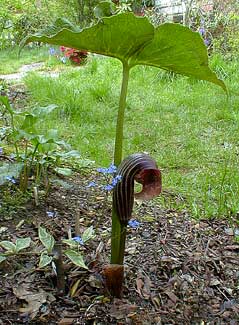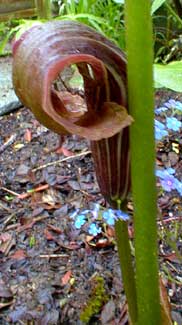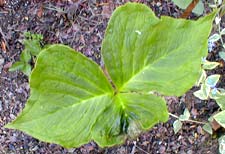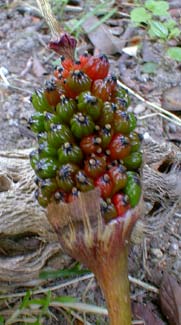
Griffith's Cobra Lily
A growing interest in unusual shade plants has produced a subsantial if specialized market for jack-in-the-pulpits from India, China & Japan, so that new varieties are constantly being introduced for the afficionado.
They are still not commonly offered in "regular" nurseries, so it is usually necessary to seek out a specialist in shade plants or in aroids. We're lucky in that two growers are within driving distance of our home, though each nursery is a day trip in opposite directions. Their stocks do not much overlap, so there are far too many species to be tempted by.
They can be pricy, & there are now so many species being offered it's too easy to get carried away accumulating too many different kinds. I personally feel like a collection of five or six species should be enough, with multiples of each type so as to increase the probability of getting the highly decorative fruits, which generally only occur if there are flowers of both sexes present.
 But I must admit I have not been able to adhere to this ideal, & have added more species to the collection even after telling myself I should restrict myself. "Collector-itis" is a real problem. Once one becomes enamored of the heads of these Cobras, it is difficult to walk past new offerings without getting excited.
But I must admit I have not been able to adhere to this ideal, & have added more species to the collection even after telling myself I should restrict myself. "Collector-itis" is a real problem. Once one becomes enamored of the heads of these Cobras, it is difficult to walk past new offerings without getting excited.A plethora of the realtively recent introductions are from the Himalayas, which seems to produce unusually large & colorful examples of the genus. Arisaema griffithii atop our shady "Pulpit Hill" is just one such example, native to the Himalayas of India. It is quite cold-hardy (to zone 6), but can suffer in heat & may require summer mulching for protection of the root. It does well in our naturally acidic soils, but will also do well in neutral pH soils; it is not fussy, other than requiring persistent moisture.
 Griffith's Cobra Lily wants bright shade. Its spathe or pulpit is large, fat, but somewhat short because springing immediately out of the ground with no stem. It's a richly maroon-striped spathe with its nose coiled in on itself, so that it is just about impossible to look inside the pulpit to see the nearly black spadix or jack.
Griffith's Cobra Lily wants bright shade. Its spathe or pulpit is large, fat, but somewhat short because springing immediately out of the ground with no stem. It's a richly maroon-striped spathe with its nose coiled in on itself, so that it is just about impossible to look inside the pulpit to see the nearly black spadix or jack.The leaves form a wrinkly umbrella of two large leaves, two feet above the ground, sheltering the spathe. A third partially developed leaf remains a wrinkly thing alongside the two full leaves. The leaves have a webwork of veining on the underside. A snapshot from overhead, taken in April, shows this unusual leaf, which remains standing tall in the garden long after the flower is gone, lasting through summer if it never dries out entirely, fading away in autumn.
 The bloom is at its height April & May (or, further north, in May & June). The leaves linger long after the bloom is finished. If per chance the spadix has female flowers, & if per chance a spadix with male flowers is nearby, the leaf-umbrella may soon be sheltering a stubby stalk of berries, as the spathe peals itself away at spring's end or in early summer.
The bloom is at its height April & May (or, further north, in May & June). The leaves linger long after the bloom is finished. If per chance the spadix has female flowers, & if per chance a spadix with male flowers is nearby, the leaf-umbrella may soon be sheltering a stubby stalk of berries, as the spathe peals itself away at spring's end or in early summer.We have but one specimen, & I don't believe they are ever self-pollinating, so it is apparent it can be cross-pollinated by other species (two other large Himalayan species were blooming in close proximity at the same time). Our lone Griffith's cobra produced a pretty seedpod, shown stripped of its dried spathe in a June portrait at right. This should have remained in the garden some while for its decorative value & to ripen more fully, but it fell over in June, so I had no choice but to harvest it prematurely.
This "corncob" of berries ripens in Autumn & that is when it should have been harvested. The seeds should be cleaned of pulp & dried, then planted before first frost. The main plant is divisable by its rhyzomes after a few years, plus it produces offsets, & spreads over time even without seeding.
The blunted coiled nose of the pulpit makes it unique among arisaemas, & the odd arrangement of leaves is likewise unique. So how could I resist adding yet another species to Pulpit Hill?
Himalayan Cobra Lily,
Arisaema nepenthoides